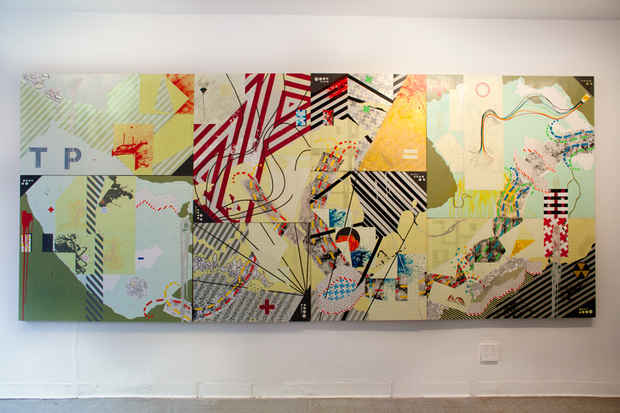Tom Brauer "Islands Never Cry"
Rawson Projects

This event has ended.
Rawson Projects presents the gallery's fourth exhibition Islands Never Cry new paintings by Tom Brauer.
Born in 1978, the artist received his MFA from Yale University, New Haven, CT in 2005 where he received the Phelps Berdan Memorial Award for distinction in painting/printmaking. Since then, he has shown widely in the United States, Europe and Japan. Most recently he was featured in a solo exhibition of his work entitled Make Haste Slowly at Motus Fort in Tokyo.
A conversation between the gallery and the artist about this project follows.
Rawson Projects: First of all, the title of the show is Islands Never Cry – a reference to a Simon and Garfunkel song. Can you talk about why you chose that title and how it relates to the work?
Tom Brauer: I was listening to the lyrics on the radio at work one morning. It's such an iconic, quintessentially romantic American song. If it’s not on the Forest Gump soundtrack it really should be. It's the kind of song you hear often but never pay much attention to even though you probably know the lyrics by heart. In that way, it’s perfectly nostalgic. I was just finishing painting this body of work and liked how the metaphor of the rock and the island worked especially in the context of this cheesy all-American classic rock song. The lyrics to the song help paint a portrait of myself as the archetypal artist in a wry and self-deprecating kind of way. To me, the title is equal parts poetic and tongue-in-cheek.
RP: These paintings draw from a variety of influences. From a historical perspective you cite everything from Jasper Johns to map-making. However, they also seem to be a very personal and specific narrative. For example, there is repetition of objects like the graph paper and the cross throughout the paintings that seems to have a very specific meaning. Can you talk about these symbols and the role of personal narrative in your work?
TB: There are many layers to this work both visually and metaphorically. The geography of the paintings is loosely based on maps I began to draw when I was 13. I read a lot of Fantasy/ Science Fiction Novels when I was a kid. These cheap paperbacks were a huge influence on my imagination. They introduced me to ideas about time and space that I didn't learn about in school. The island in Islands Never Cry is a map of the area I grew up in upstate New York. It was a very rural part of the state, and I was fortunate to roam a large swath of land. I was an explorer roaming a post-industrial/agricultural landscape and the maps became a record of what I found along the way. As I got older, this landscape became the backdrop of my later paintings. In my mind these are maps of a psychological landscape. I've lived in New York City now for ten years. The interesting thing about this body of work to me is it is a complete synthesis of the experience of both living upstate and in the City.
There is a double meaning in everything I paint. I use the graph paper as a ground often because it was what I drew on when I was a kid. My Dad would bring home ledgers from work for me to draw on. Native Americans also drew on similar ledger pads furnished by European colonists. The metaphor is deeply rich to me here. A similar symbol that also has resonance in my work is the red cross. The red cross is a global symbol for medical assistance. If you turn the symbol on its side, the cross becomes a red X as in "X marks the spot." It also is a "plus" sign that in a particular medical context can mean positive for pregnancy or HIV. How I place this symbol in the context of other symbols in my paintings is very particular, and, more often than not, this juxtaposition goes beyond an autobiographical narrative and hopefully resonates in the viewer.
RP: One discussion we had that really helped me to understand your work was about the 15th Century text Hypnerotomachia Poliphili. Written by a monk, the text is a stream of consciousness account of a dream that is as much a study in classical architecture as it is a recounting of an erotic fantasy. Your work, as well, seems to combine a study in space and geography with erotic elements. What about this type of text do you find attractive? What about these sorts of narratives do you find relevant to contemporary urban life?
TB: The Hypnerotomachia Poliphili was a book I was assigned to read in grad school. Besides painting, I'm deeply interested in landscape architecture. I took a course in the history of Landscape Architecture in the Western World and my professor asked me to do a presentation on this very influential book. As you mentioned, the book was written by a monk and describes Poliphilo wandering through a garden of astounding visual opulence in search of his love Polia. What struck me about the story was the role of the gardens and the architecture in the book. Every flower and trellis has this highly charged erotic undertone that constrains and inspires Poliphilo at the same time. In my paintings, I'm interested in drawing a similar tension between our carnal desire and the architecture constructed around us.
Media
Schedule
from April 28, 2011 to June 05, 2011
Opening Reception on 2011-04-28 from 19:00 to 21:00